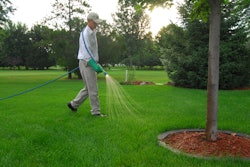
While phosphorus-free fertilizer has become the “norm” for lawn and landscape fertilizers, sometimes phosphorus is needed. Phosphorus is useful in the promotion of turf and landscaping planting root development and establishment; however, if used incorrectly, phosphorus fertilizers can be an environmental concern.
Excessive or incorrect phosphorus fertilizer use can lead to algal growth in surface waters. While the larger environmental focus is on the impact of algae growth in large bodies of water like the Great Lakes and the Chesapeake Bay, it also has a direct impact on water features on and around the properties you manage.
Phosphorus is an essential element required for plant growth by promoting root development, is a structural component of cell walls of plants and key in energy transfer within plants. In undisturbed soil environments, phosphorus is concentrated near the surface where shallow rooted plants can access it.
Often, professional landscapers are working with disturbed sites. The topsoil may have been stripped from the site or mixed with phosphorus deficient sub soil. In highly disturbed sites, the soil pH may be very low, or very high, leading to a chemical tie-up of the phosphorous in forms that are not available to plants. In many cases, the lack of availability of phosphorus to the turf can lead to poor establishment and possible failure of seeding or sod installations.
The key to effective phosphorus fertilizer use is to follow recommendations based on soil test levels and ensure the fertilizer is incorporated into the soil by tillage, watering or a light rain before a heavy rain fall even occurs. Phosphorus fertilizer can be effectively incorporated with as little as 0.1 inch of water.
While nearly 20 states have phosphorus fertilizer bans in place, all of them have a common theme. Phosphorus fertilizer application is allowed when a soil test indicates that additional phosphorus is needed for growth and/or repair of that lawn.
To avoid environmental concerns associated with the application of phosphorus fertilizers, follow these steps:
1. Do not apply without a soil test. Risk of off-site movement of applied phosphorus increases as soil test levels increase.
2. Incorporate phosphorus fertilizer into the soil whenever possible. Incorporation of phosphorus fertilizer into the soil can significantly reduce off-site movement.
3. Split the phosphorus fertilizer into multiple applications, especially on sandy soils. This reduces the amount of phosphorus that is at risk of off-site movement at any one time.
4. Do not apply right before a heavy rain. Do not apply phosphorus less than 12 to 24 hours before a heavy rainfall event. Phosphorus fertilizer can dissolve and move with stormwater flow. If the rain is heavy enough, the fertilizer granules can be washed away. The longer the phosphorus fertilizer is in contact with the soil before a heavy rainfall, the less likely it is to move off-site.
5. Sweep phosphorus fertilizer off paved and concrete surfaces. Fertilizer landing on impermeable surfaces can be carried by rainwater to storm drains.
6. Do not apply too close to open water and allow a buffer to ensure no fertilizer goes directly to surface waters.
7. In the northern states, do not apply when the soil is frozen. Frozen soil can act just like a paved surface.
When following phosphorus fertilizer recommendations, be certain to make sure that the soil test results match the recommendation charts. There is more than one lab test method used to measure soil phosphorus levels. The numerical values from the different test methods can vary tenfold, so is it critical that the lab test method used at the soil lab matches the fertilizer recommendation charts being used. While many soils labs will provide nutrients, it is best to verify that those recommendations comply with your state laws. Often lab recommendations for turf and landscape are in line with or lower than state guidelines.
While homeowners are asking lawn care professionals to limit use of fertilizers, a soil test can help dial in a specific and efficient fertility program. Some of these same customers are looking to biological and biosolid based fertilizers that often have a phosphorus content. To use biological and biosolid fertilizers correctly, a soil test is required. The “easy button” way of managing law fertility is to simply us only phosphorus-free fertilizers but could incorporating a soil test into your service offerings and applying the appropriate nutrients though customized nutrient management plans for your customers be a marketplace differentiator for your business?




















